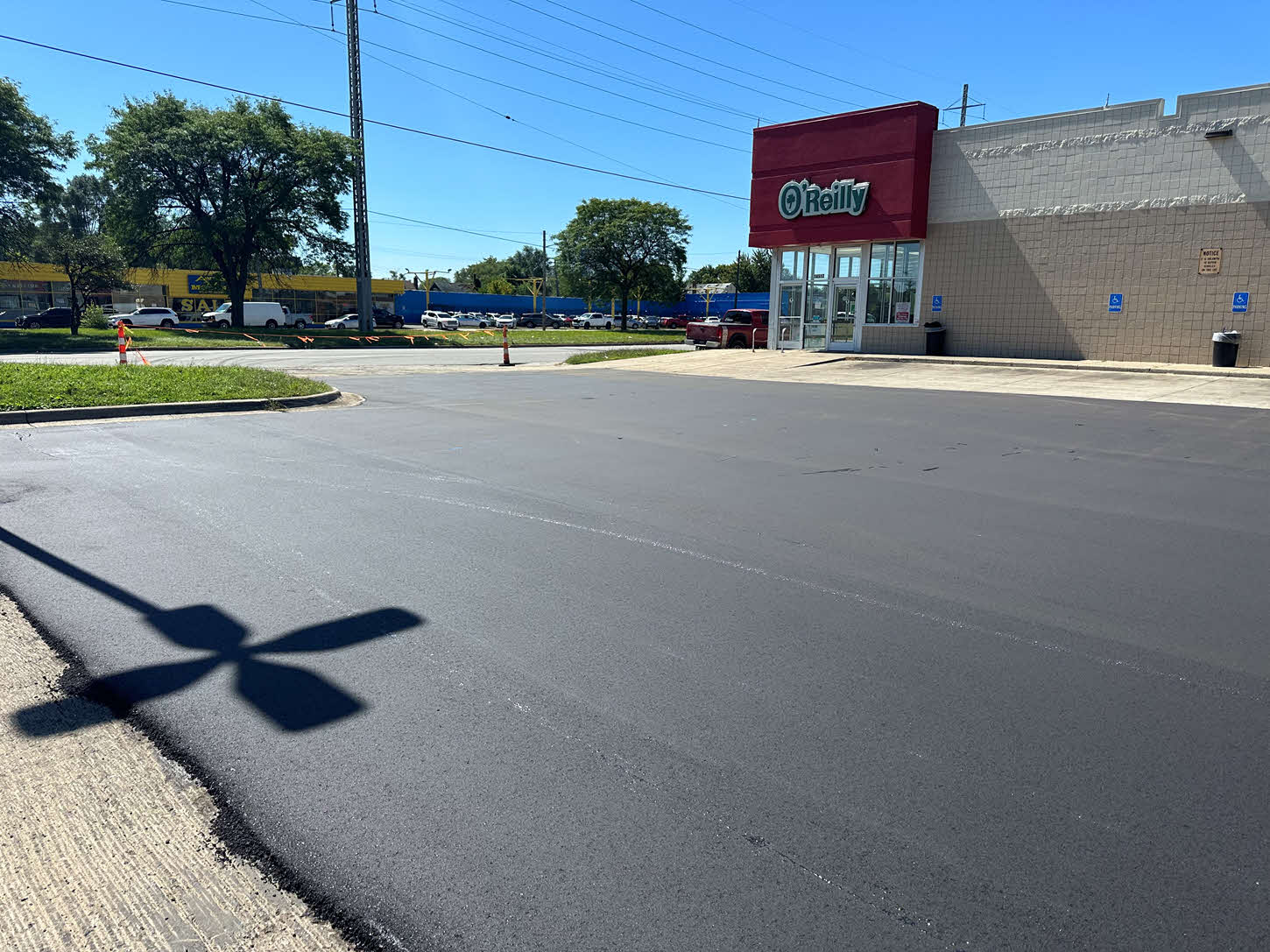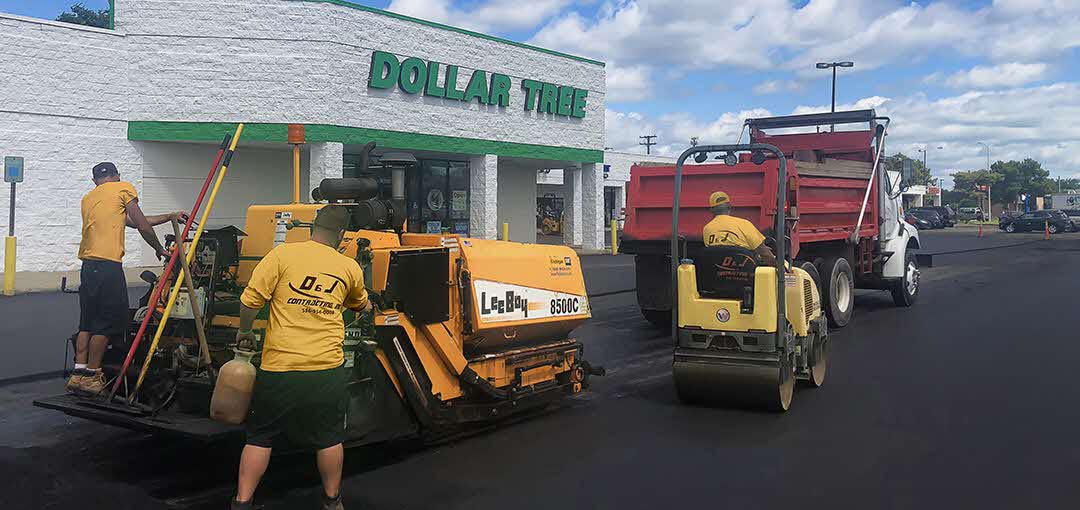Overlay inFraser, MI
Durable Overlay Solutions for a Stronger, Longer-Lasting Surface
We Are Locally Owned & Operated For Over 37 Years
Contact Us Today!
We Serve Businesses In And Around The Following Cities:
About Overlay
Guide to Overlay Applications in Fraser for Commercial Properties
Understanding Overlay Techniques
When navigating the intricacies of commercial property maintenance in Fraser, one term that consistently emerges is “Overlay.” It refers to a strategy commonly employed to rejuvenate surfaces without the need for complete removal and reconstruction. For commercial property owners, overlay applications, particularly on parking lots, can extend the life of asphalt surfaces efficiently and economically. This approach complements the fast-paced commercial environment of Fraser, where maintaining operational efficiency is paramount.
Overlay, in its essence, involves applying a new layer of asphalt to an existing surface. This process serves as a robust solution to the cosmetic and structural issues often encountered in parking areas and driveways. By opting for this method, businesses can address problems such as minor cracks, surface wear, and drainage challenges without the extensive downtime associated with full resurfacing.
The Process of Overlay Application
Embarking on an overlay project begins with understanding the specific needs of the property in question. A thorough evaluation is crucial to determine the suitability of overlay as a solution. Commercial properties often feature high-traffic areas that endure significant wear and tear. Therefore, assessing the structural integrity of the existing asphalt is essential. The process typically involves cleaning the surface and removing any debris before applying a leveling layer to smooth out irregularities.
Once the preparation phase is complete, the overlay material is applied. This part of the process sees the infusion of new asphalt atop the existing surface, resulting in a smooth, durable layer. The benefits of this method are not limited to aesthetics alone; it also enhances the parking lot’s durability, providing an extra layer of protection against environmental factors and daily use.
Benefits for Commercial Properties
For any business situated in Fraser, ensuring that their facilities are presentable and functional is fundamental to their brand image and operational success. Undertaking an asphalt overlay on parking areas contributes significantly to achieving these objectives. Enhanced aesthetics deliver a welcoming first impression for customers, while improved surface conditions enhance safety for both vehicles and pedestrians.
Moreover, overlaying extends the lifespan of existing asphalt, proving economically advantageous in the long run. The cost-effective nature of overlaying, compared to complete resurfacing, allows businesses to allocate their maintenance budgets more strategically, optimizing financial resources. Additionally, the application process is relatively swift, minimizing disruptions to business operations, which is a critical consideration for high-traffic establishments.
Real-World Applications and Success Stories
In Fraser, businesses have continually turned to overlay processes to meet their maintenance needs. Restaurant chains and retail centers, which see constant patronage, often employ parking lot overlay techniques to refresh their properties. This method has proven invaluable for age-old establishments wishing to maintain a modern, well-kept image without closing down for lengthy periods.
One notable example involves a bustling shopping center that partnered with D&J Contracting. Their expertise in Parking Lot Asphalt Overlay enabled a seamless refurbishment weekend, rejuvenating the property with minimal disruption. The transformation was visible, and the durable surface application improved customer experiences and bolstered safety substantially.
Parking Area Rehabilitation
Particularly in climates like Fraser’s, where seasonal changes challenge surfaces with cycles of freezing and thawing, parking area rehabilitation is a necessity more than an option. Over time, temperature fluctuations can exacerbate small cracks, leading to larger fissures and uneven surfaces. Confronting this issue with a comprehensive overlay prevents minor issues from escalating into prohibitive costs.
As a viable part of an ongoing maintenance strategy, overlay stands as an efficient method of parking area rehabilitation. Using asphalt overlay as a tool, commercial entities can adapt to weather-related impacts proactively. This allows businesses to maintain uninterrupted operations year-round, particularly important for areas like Fraser with variable climatic conditions.
Durable Surface Applications
Overlay techniques do more than renew aesthetics; they fortify surfaces against environmental stresses. A critical factor is the choice of materials and application techniques. In Fraser, where durable surface applications are a priority, addressing the inherent challenges of heavy traffic and weather is essential.
With advances in material technology and application methods, overlays now offer a durability that supports the demands of commercial infrastructures. When high-quality materials are coupled with expert installation, like that provided by D&J Contracting, the results speak for themselves. Businesses can enjoy improved surface resilience that reduces maintenance needs and associated costs over time.
In conclusion, adopting overlay practices for commercial properties in Fraser offers multiple advantages. From extending the life and quality of parking lots to enhancing the visitor experience, the benefits of overlay applications are notable. By engaging specialists like D&J Contracting, businesses can ensure that their investments translate into enhanced property value and customer satisfaction. For any commercial establishment aiming to sustain its relevance and functionality, embracing overlay solutions is indeed a strategic choice. As property challenges evolve, so too should the methods employed to address them, ensuring continuous improvement in service and presentation.
Overlay Gallery


Call Us Today to receive your Free Quote for
Overlay in Fraser
Serving: Fraser, Michigan

About Fraser, Michigan
The village of Fraser was incorporated by an act of the state legislature in 1894. It was named for a lawyer from Detroit named Alexander J. Frazer. The city of Fraser was established by home rule charter November 7, 1956, and adopted by the electors on December 26, 1956.
Fraser is in southern Macomb County, six miles (10 km) southwest of Mount Clemens, the county seat, and 15 miles (24 km) northeast of downtown Detroit. The city is nearly square, bounded by 15 Mile Road, Kelly Road, 13 Mile Road, and Hayes Road. It is bordered to the north and northeast by Clinton Charter Township, to the southeast and south by Roseville, to the southwest by Warren, and to the northwest by Sterling Heights. Highway M-97 (Groesbeck Highway) passes through the southeast part of the city, connecting Mount Clemens and Detroit.
According to the U.S. Census Bureau, Fraser has a total area of 4.16 square miles (10.77 km), of which 4.14 square miles (10.72 km) are land and 0.02 square miles (0.05 km), or 0.38%, are water. Harrington Drain and its tributary, Sweeny Drain, flow northward through the city, Harrington Drain joining the Clinton River, a tributary of Lake St. Clair, in Mount Clemens.
| Census | Pop. | Note | %± |
|---|---|---|---|
| 1900 | 252 | — | |
| 1910 | 220 | −12.7% | |
| 1920 | 247 | 12.3% | |
| 1930 | 600 | 142.9% | |
| 1940 | 747 | 24.5% | |
| 1950 | 1,379 | 84.6% | |
| 1960 | 7,027 | 409.6% | |
| 1970 | 11,868 | 68.9% | |
| 1980 | 14,560 | 22.7% | |
| 1990 | 13,899 | −4.5% | |
| 2000 | 15,297 | 10.1% | |
| 2010 | 14,480 | −5.3% | |
| 2020 | 14,726 | 1.7% | |
| 2023 (est.) | 14,434 | −2.0% | |
| U.S. Decennial Census | |||
As of the census of 2010, there were 14,480 people, 6,105 households, and 3,954 families living in the city. The population density was 3,497.6 inhabitants per square mile (1,350.4/km). There were 6,448 housing units at an average density of 1,557.5 per square mile (601.4/km). The racial makeup of the city was 92.0% White, 3.9% African American, 0.5% Native American, 1.5% Asian, 0.3% from other races, and 1.8% from two or more races. Hispanic or Latino residents of any race were 2.1% of the population.
There were 6,105 households, of which 29.0% had children under the age of 18 living with them, 46.4% were married couples living together, 14.1% had a female householder with no husband present, 4.3% had a male householder with no wife present, and 35.2% were non-families. 31.4% of all households were made up of individuals, and 14.5% had someone living alone who was 65 years of age or older. The average household size was 2.36 and the average family size was 2.96.
The median age in the city was 42.9 years. 21.4% of residents were under the age of 18; 7.8% were between the ages of 18 and 24; 24.1% were from 25 to 44; 30.6% were from 45 to 64; and 16.2% were 65 years of age or older. The gender makeup of the city was 46.4% male and 53.6% female.
As of the census of 2000, there were 15,297 people, 6,062 households, and 4,122 families living in the city. The population density was 3,652.5 inhabitants per square mile (1,410.2/km). There were 6,178 housing units at an average density of 1,475.2 per square mile (569.6/km). The racial makeup of the city was 96.67% White, 0.91% African American, 0.26% Native American, 0.93% Asian, 0.01% Pacific Islander, 0.21% from other races, and 1.01% from two or more races. Hispanic or Latino residents of any race were 1.33% of the population.
There were 6,062 households, out of which 31.7% had children under the age of 18 living with them, 53.0% were married couples living together, 12.5% had a female householder with no husband present, and 32.0% were non-families. 28.2% of all households were made up of individuals, and 12.7% had someone living alone who was 65 years of age or older. The average household size was 2.49 and the average family size was 3.08.
In the city, 24.2% of the population was under the age of 18, 7.9% was from 18 to 24, 29.1% from 25 to 44, 23.4% from 45 to 64, and 15.4% was 65 years of age or older. The median age was 39 years. For every 100 females, there were 87.1 males. For every 100 females age 18 and over, there were 81.8 males.
The median income for a household in the city was $50,339, and the median income for a family was $64,119. Males had a median income of $50,243 versus $29,254 for females. The per capita income for the city was $22,864. About 3.4% of families and 4.2% of the population were below the poverty line, including 5.3% of those under age 18 and 4.4% of those age 65 or over.
Fraser Public Schools is the public school system in Fraser. The district scores above the state average on the MEAP Test.
Also located in Fraser is the Arts Academy in the Woods, a free public charter academy dedicated to students interested in pursuing fine and performing arts.
Call Us Today to receive your Free Quote for
Overlay in Fraser
Related Services in Fraser, Michigan
We Serve Businesses In The Following Zip Codes:
48007, 48015, 48021, 48026, 48035, 48036, 48038, 48042, 48043, 48044, 48045, 48046, 48047, 48048, 48050, 48051, 48066, 48071, 48080, 48081, 48082, 48083, 48084, 48085, 48088, 48089, 48090, 48091, 48092, 48093, 48098, 48099, 48225, 48230, 48236, 48310, 48311, 48312, 48313, 48314, 48315, 48316, 48317, 48318, 48397